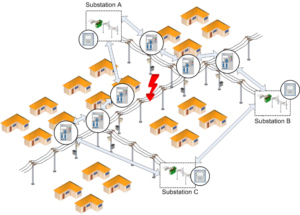The SliceNet project brings forward an innovative verticals-oriented solution for cognition-based 5G network slicing and slice management. The project takes a verticals-in-the-loop co-design approach, in which high-level requirements for 5G communications from different business sectors are being accounted for from the earliest stages, influencing the SliceNet architecture design and definition. One of these business sectors is that of the energy industry. It is of paramount importance in the energy industry to maintain availability of electricity supply to its customers.
The 5G Smart Grid Self-Healing use case, focuses on fully decentralized high-speed self-healing solutions for the electrical power grid, based on 5G communications. See diagram showing a decentralized self-healing scheme based on device-to-device communication.
These self-healing solutions rely on distributed automation and power system protection, and aim at increasing energy supply Quality of Service (QoS) by reducing the number of customers affected by power outages, as well as the frequency and duration of these outages.
The SliceNet 5G framework aims to meet the challenging communication requirements currently imposed by smart grid applications, which are currently not fully achievable by fourth generation communications. 5G communications will provide the necessary industry-ready, cost-effective, secure, very low latency, ultra-reliable wide-area communication infrastructure.

Figure 5. Fully decentralized self-healing scheme based on device-to-device communication.
